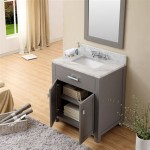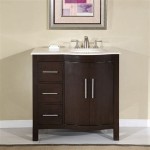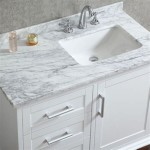Master Bathroom Double Sink Vanities: A Comprehensive Guide
The master bathroom stands as a sanctuary within the home, a space dedicated to personal care and relaxation. In contemporary design, the double sink vanity has emerged as a highly sought-after feature, offering both practical benefits and aesthetic enhancements. This article explores the multifaceted aspects of master bathroom double sink vanities, providing a comprehensive overview of their advantages, design considerations, material choices, installation nuances, and maintenance recommendations.
A double sink vanity, as the name suggests, incorporates two sinks into a single vanity unit. This arrangement inherently doubles the space available for personal hygiene tasks, allowing two individuals to comfortably use the bathroom simultaneously. This is particularly beneficial in households with multiple occupants who share the master bathroom, especially during peak morning and evening routines. The presence of two sinks significantly reduces congestion and minimizes the likelihood of scheduling conflicts, contributing to a more harmonious living environment. Beyond purely functional benefits, double sink vanities also contribute to the overall aesthetic appeal of the master bathroom, often serving as a focal point that elevates the room's design.
Advantages of Incorporating a Double Sink Vanity
The decision to incorporate a double sink vanity into a master bathroom design involves weighing various factors, primarily centered around functionality, space constraints, and aesthetic preferences. However, the advantages are numerous and often outweigh the potential drawbacks, making it a compelling choice for many homeowners.
One of the most significant advantages is the increased efficiency in shared bathroom spaces. In the typical morning rush, multiple family members often vie for access to the sink for brushing teeth, washing faces, or applying makeup. With a double sink vanity, each individual can have their designated space, eliminating the need to wait and minimizing disruptions to their routines. This not only saves time but also reduces stress levels, contributing to a more positive start to the day. This efficiency extends beyond the morning routine; at any time of day, the availability of two sinks provides greater flexibility for personal care tasks.
Beyond the time-saving aspect, double sink vanities provide a personalized space for each user. Each individual can customize their sink area with their preferred toiletries, towels, and accessories. This level of personalization enhances the sense of ownership and comfort within the shared bathroom space. It also allows for better organization, as each user can keep their personal items separate and readily accessible. This is particularly beneficial for couples or individuals who have different product preferences or routines.
Furthermore, a double sink vanity can significantly increase the storage capacity within the master bathroom. Most double sink vanities incorporate ample cabinet space, drawers, and shelving units beneath the sinks. This storage can be used to house toiletries, towels, cleaning supplies, and other bathroom essentials, helping to keep the countertop surfaces clear and clutter-free. A well-organized vanity contributes to a more visually appealing and functional bathroom environment. The increased storage also reduces the need for additional storage solutions elsewhere in the bathroom, such as wall-mounted shelves or freestanding cabinets, which can help to maximize the available floor space.
Finally, the addition of a double sink vanity can enhance the aesthetic appeal and perceived value of the master bathroom. A well-designed double sink vanity can serve as a focal point in the room, adding a touch of luxury and sophistication. It can also complement the overall style and décor of the bathroom, creating a cohesive and visually pleasing space. In terms of home value, a master bathroom with a double sink vanity is often considered a highly desirable feature by potential buyers, potentially increasing the resale value of the property.
Key Design Considerations for Double Sink Vanities
Choosing the right double sink vanity involves careful consideration of various design elements, including size, style, material, countertop options, and plumbing requirements. A well-thought-out design will ensure that the vanity not only meets the functional needs of the users but also complements the overall aesthetic of the master bathroom.
The size of the vanity is a crucial factor to consider, as it must be proportional to the size of the bathroom. A vanity that is too large can overwhelm a small bathroom, making it feel cramped and uncomfortable. Conversely, a vanity that is too small can appear insignificant in a large bathroom. It is essential to measure the available space accurately and choose a vanity size that fits comfortably within the room. The standard height for bathroom vanities is typically between 30 and 36 inches, but taller individuals may prefer a vanity with a higher countertop. The depth of the vanity should also be considered, as a deeper vanity will provide more countertop space and storage capacity. Consider the space needed for comfortably moving around the vanity, opening drawers and cabinet doors, and using the sinks simultaneously.
The style of the vanity should complement the overall décor of the master bathroom. Double sink vanities are available in a wide range of styles, from traditional to modern to contemporary. Traditional vanities often feature ornate details, raised panel doors, and antique-inspired hardware. Modern vanities tend to have clean lines, minimalist designs, and sleek finishes. Contemporary vanities may incorporate a mix of traditional and modern elements, creating a unique and stylish look. The style of the vanity should also be consistent with the other fixtures and finishes in the bathroom, such as the toilet, bathtub, and shower.
The choice of materials is another important consideration, as it will affect the durability, appearance, and maintenance requirements of the vanity. Common materials for vanity cabinets include solid wood, plywood, MDF (medium-density fiberboard), and particleboard. Solid wood is the most durable and expensive option, while plywood and MDF are more affordable alternatives. Particleboard is the least expensive option but is also the least durable. The countertop material is equally important, as it will be exposed to water, soap, and other substances. Popular countertop materials include granite, quartz, marble, and engineered stone. Each material has its own unique characteristics in terms of durability, maintenance, and aesthetic appeal. Granite and quartz are known for their durability and resistance to stains, while marble offers a luxurious and elegant look. Engineered stone is a more affordable alternative that offers a similar appearance to natural stone.
Finally, the plumbing requirements for a double sink vanity should be carefully considered. Two separate water supply lines and drain pipes will be required for each sink. It is essential to ensure that the existing plumbing infrastructure is adequate to accommodate the double sink vanity. If necessary, a qualified plumber may need to install additional plumbing lines. The placement of the plumbing lines should also be considered, as they will need to be concealed within the vanity cabinet. Proper planning and installation of the plumbing will ensure that the double sink vanity functions properly and without leaks.
Material Options and Maintenance for Long-Term Durability
The selection of materials for a double sink vanity significantly impacts its lifespan, aesthetic appeal, and maintenance requirements. A thorough understanding of the properties of different materials is crucial for making informed decisions that align with both personal preferences and practical considerations. Proper maintenance practices are also essential for preserving the beauty and functionality of the vanity over time.
For the vanity cabinet itself, solid wood options like oak, maple, cherry, and walnut offer exceptional durability and a natural aesthetic. These hardwoods resist warping and cracking better than engineered wood products, however, they require proper sealing to prevent water damage. Engineered wood alternatives such as plywood and MDF are more affordable and less susceptible to moisture damage if properly sealed, but may not offer the same level of structural integrity as solid wood. Particleboard is commonly used in budget-friendly vanities but is the least water-resistant and durable option. When selecting a cabinet material, consider the humidity levels in the bathroom and the frequency of water exposure to ensure long-term performance. Regardless of the material, a high-quality finish or sealant is essential to protect the wood from moisture and prevent damage.
Countertop materials vary widely in terms of appearance, durability, and maintenance requirements. Granite is a popular choice for its natural beauty, heat resistance, and durability. However, it is porous and requires periodic sealing to prevent staining. Quartz, an engineered stone, offers similar aesthetic appeal to granite but is non-porous and therefore more resistant to stains and bacteria. Marble is a luxurious option known for its elegant veining, but it is also porous and prone to scratching and etching. Concrete countertops offer a modern, industrial aesthetic, but require sealing and waxing to maintain their appearance. Laminate countertops are the most affordable option but are susceptible to scratches and water damage. Solid surface materials like Corian are non-porous, seamless, and easy to clean, making them a practical choice for bathroom vanities.
Maintaining a double sink vanity involves regular cleaning and preventive measures to protect the materials from damage. Countertops should be wiped down daily to remove spills and prevent stains from setting. A mild, non-abrasive cleaner should be used to clean the countertops, and harsh chemicals or abrasive scrubbers should be avoided. For granite and marble countertops, a pH-neutral cleaner specifically designed for natural stone should be used. Cabinet doors and drawers should be cleaned regularly with a damp cloth to remove dust and grime. Hinges and drawer slides should be lubricated periodically to ensure smooth operation. Water spills should be wiped up immediately to prevent water damage to the cabinet. It is also important to ensure proper ventilation in the bathroom to prevent moisture buildup, which can lead to mold and mildew growth. Regularly inspect the plumbing connections for leaks and address any issues promptly to prevent water damage to the vanity and surrounding areas. Implementing these maintenance practices will ensure that the double sink vanity remains in good condition for years to come.

Pin On Home Ideas

Dual Or Single Bowl Vanity Is One Two Master Bathroom Sinks Best Degnan Design Build Remodel

Top Vanity Sink And Mirror Style Picks For Master Baths In 2024

Master Bathroom Vanity Design Ideas

40 Bathroom Vanities You Ll Love For Every Style

Find Out If Your Home Needs A Double Sink Vanity

Master Bath Debate Double Or Single Bowl Vanities Dura Supreme Cabinetry

East Side Dream Master Bath Rhode Kitchen Design Build

Gorgeous Double Vanity Design Ideas Bathrooms With Vanities

Pin On Bathroom Renovation
See Also







